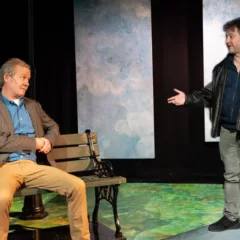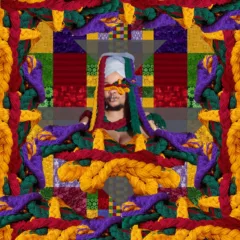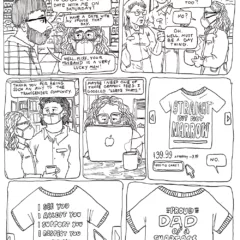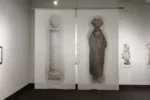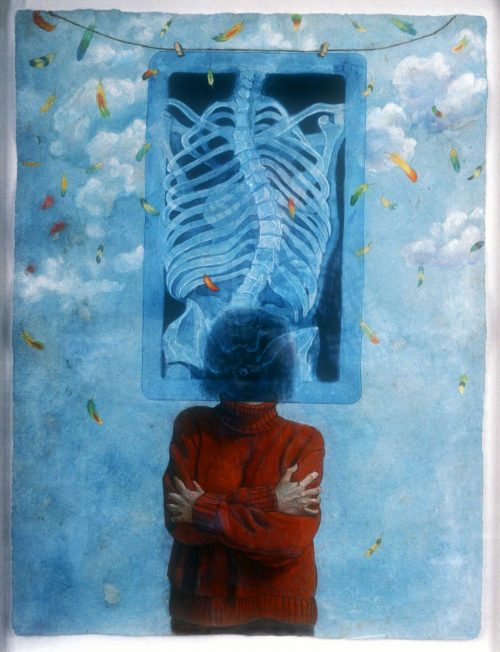
36” x 24”, Gouache on Amate paper | Private collection. Artwork © 2020 by Riva Lehrer, from GOLEM GIRL
[ED. Note: This week, Natalie Sandstrom will record the first of three podcasts in a limited Artblog Radio series surrounding cultural accessibility. Make sure to stay tuned and keep an eye out for the podcast on Artblog’s front page, or in our Weekly Newsletters, on Apple Podcasts, or Spotify!]
The Book
In the prologue of Golem Girl, artist Riva Lehrer sets up her extended metaphor that will come up again and again over the next nearly 400 pages. The word “monster,” she explains, comes from Latin words meaning ‘warning’ and ‘omen’, and references thousands of years of golem stories: creatures built by human hands and magically animated to serve some purpose of their creator. Think Frankenstein’s monster. Riva says “My body was built with human hands… [though] if I once was monere [Latin for monster], I’m turning myself into monstrare: one who unveils” (pp. xv). For her, this unveiling is done through the creation of portraits of other members of the disability community.
Lehrer was born in 1958 in Ohio. She is an artist, activist, writer, teacher, member of the LGBTQIA+ community, a Jewish woman, and self-described “mouthy broad.” Why does she identify with golems? She was born with spina bifida (which occurs when the spine and spinal cord do not form properly in a fetus), and has undergone dozens of surgeries in her lifetime: as she explained in her March 12 book talk for the NYU Center for Disability Studies, “I have always felt like a construction. …built by doctors and surgeons… by my mother… and later by society that took me apart and tried to make me something else… my body is always changing, there is always another surgery.” *
In her memoir, Lehrer explores the intersection of her disability, sexuality, gender, and religion. However, she investigates these ideas with an eye toward larger questions: what do different identities mean, and how do they outwardly manifest in certain places and points of time? Although the book centers on Lehrer’s life and artistic practice from her birth through the middle of 2020, readers are introduced to many other people and communities in her orbit, are privy to questions of religion and disability (Judaism has a very famous golem story), and get a front row seat to disability activism, feminism, artistic practice, and questions of belonging.
The book unpacks Lehrer’s lifetime of work as an artist and Disability Culture activist. She writes about her childhood, about what it was like to attend a day school for children with disabilities (a rare occurrence before the passage of the 1975 Education for All Handicapped Children Act). We go through her teenage years with her, and witness her relationship with her mother. Readers follow along to art school and the decades after, during Riva’s burgeoning career as an artist. We are with her as she becomes an anatomy drawing professor at the Art Institute of Chicago, teaching medical students to look at bodies in new ways. Along the way there are celebratory moments of love and intimacy, and explorations of sexuality, but readers are also exposed to a number of harsh realities. Riva, like so many others, was a part of the ongoing history of sterilization of disabled women. In her case, a uterine cyst led to a hysterectomy in high school. Could her procreative ability have been saved if her doctors had recognized her pain earlier? Shortly after this procedure, Riva requests (and ultimately gets) the “great milestone of Jewish womanhood” – a nose job (pp. 140). She admits that “this was the first time I’d ever asked for a surgery. A very perverse act” given her many prior operations (pp. 141). In this and other moments Riva grapples with her own internalized standards and ableism : “I had spent years fighting against misogyny, homophobia, and anti-Semitism, yet I’d so easily believed that I should be ashamed of my body that I’d never understood that shame was both the product of and tool of injustice” (pp. 242).
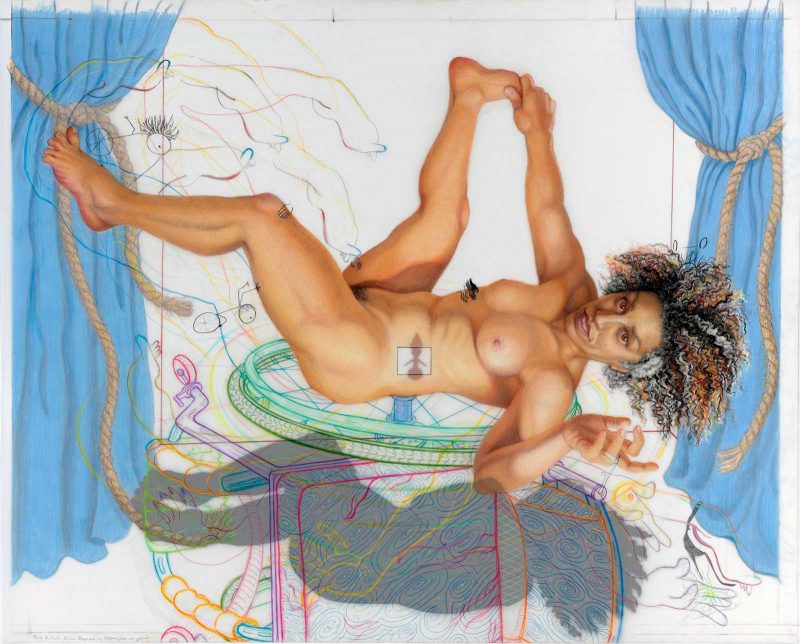
In one particularly striking chapter, Riva comes to Philly, and visits the Mütter Museum. She explores the collection, and ultimately comes face-to-face with “two entire shelves of jars [of fetuses] dedicated to spina bifida” (pp. 340-1). The emotional impact is intense, and she communicates it beautifully to us readers. It is around this part of the book where we are also spending more time with Lehrer’s artist practice, and the subjects of that work: fellow members of the disability community. For example, she writes about series like The Risk Pictures, in which Lehrer, by pre-arrangement and consent with the sitter, leaves her subject in her home for a few hours in the middle of the portrait session, letting them add to the portrait, dig through her belongings, occupy her space in a way equal to the way she occupies theirs by capturing their likeness. This balance of vulnerability rings throughout her art, and her writing. Her art, she says, is a kind of collaboration: “My subject is separate from me,” she begins on page 351, but “the way an artist paints or draws is a record of their height, eyesight, motor skills, cognition, endurance, wingspan, and muscular strength. A handmade artwork is the product of the body (or bodies) that made it happen.”
The Book Talk
In the March 12 NYU program, Riva explained that this book was not originally intended to be a memoir. She began writing to provide her family with a document about her artwork for after she is dead. She wanted to showcase her art, talk about her portraiture process and the implications of representing disabled bodies, and leave a record. However, Lehrer says that “these artworks are my history, so they are the story of who I am.” It was inevitable, it seems, that this book should become a life story, but it is also Lehrer’s art catalog: full color reproductions populate the text, and there is even a comprehensive index with long descriptions of the content and context of each artwork pictured. The images are intentionally placed throughout the book, though are not chronological. They connect to the text thematically, metaphorically, or temporally. For example, one page features a portrait by Lehrer of disability scholar and CODA (Child of Deaf Adults) Lennard Davis. This same page includes a sketch that Davis did of Riva while she was painting him. This faces a page of text that ruminates on what Lehrer calls “leakage,” the subconscious “physical resemblance [of the artist] in the portraits of their subject” (pp. 353).
Riva Lehrer’s work is energetic, colorful, rife with textures, full of movement. She takes great care in depicting others, in part because her work focuses on a marginalized community. How do you portray a disabled body without further entrenching ableist norms? In the NYU program, Lehrer said that “when you do an image of a disabled person… the ableist world assumes that disability is defined by pain… that [pain] is the real thing… and everything else [about them] is spackled onto that.” She never paints pain. She instead approaches her subjects as “bodies of potential.” People with disabilities, including Riva herself, “are so examined, challenged, stared-at, misunderstood,” that they become hyper-aware of their look and movement. Riva describes this awareness as “disability beauty:” “the way that people strenuously inhabit their bodies.” This beauty is central to her practice.
Lehrer ended the NYU program by saying that “painting is very intimate, is a very quiet, embodied conversation with someone else’s artwork.” This intimate, embodied conversation is the same experience as reading Golem Girl. The book is at times disturbing, hilarious, historically enlightening, and is always welcoming and generous. It is not only a wonderfully written account of one person’s fascinating life, but also a beautiful object full of entrancing artwork. It makes you question what “normal” means, forces you to look at the limits and the expansiveness of bodies, and see once again the awesome expressive and connective power of art.
“Golem Girl” by Riva Lehrer, published by One World, an imprint of Penguin Random House, 2020, can be purchased on Penguin Random House’s website. A recording of the March 12, 2021 event “’Golem Girl: A Memoir’ – A Reading & Conversation with authors/artists/disability activists Riva Lehrer and Sunaura Taylor” at the NYU Center for Disability Studies will be available at this link beginning in mid-April.
* All quotes are from the March 12 virtual talk unless noted otherwise.


